
Tanzania, officially the United Republic of Tanzania, is a country in East Africa within the African Great Lakes region. It borders Uganda to the north; Kenya to the northeast; the Indian Ocean to the east; Mozambique and Malawi to the south; Zambia to the southwest; and Rwanda, Burundi, and the Democratic Republic of the Congo to the west. Mount Kilimanjaro, Africa's highest mountain, is in northeastern Tanzania. According to the 2022 national census, Tanzania has a population of nearly 62 million, making it the most populous country located entirely south of the equator.
The modern-day African Great Lakes state of Tanzania dates formally from 1964, when it was formed out of the union of the much larger mainland territory of Tanganyika and the coastal archipelago of Zanzibar. The former was a colony and part of German East Africa from the 1880s to 1919’s when, under the League of Nations, it became a British mandate. It served as a British military outpost during World War II, providing financial help, munitions, and soldiers. In 1947, Tanganyika became a United Nations Trust Territory under British administration, a status it kept until its independence in 1961. The island of Zanzibar thrived as a trading hub, successively controlled by the Portuguese, the Sultanate of Oman, and then as a British protectorate by the end of the nineteenth century.

Sisal is a species of flowering plant native to southern Mexico, but widely cultivated and naturalized in many other countries. It yields a stiff fibre used in making rope and various other products. The sisal fibre is traditionally used for rope and twine, and has many other uses, including paper, cloth, footwear, hats, bags, carpets, geotextiles, and dartboards. It is also used as fibre reinforcements for composite fibreglass, rubber, and concrete products. It can also be fermented and distilled to make mezcal.

Julius Kambarage Nyerere was a Tanzanian anti-colonial activist, politician, and political theorist. He governed Tanganyika as prime minister from 1961 to 1962 and then as president from 1962 to 1964, after which he led its successor state, Tanzania, as president from 1964 to 1985. He was a founding member and chair of the Tanganyika African National Union (TANU) party, and of its successor Chama Cha Mapinduzi, from 1954 to 1990. Ideologically an African nationalist and African socialist, he promoted a political philosophy known as Ujamaa.

Tanga is the most northerly port city of Tanzania on the west of the Indian Ocean, and the capital of Tanga Region. It had a population of 393,429 in 2022. The city is also home to the Port of Tanga. The name Tanga means "sail" in Swahili.
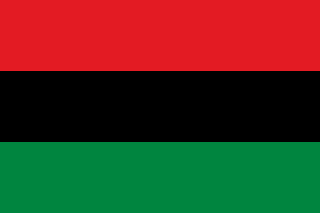
African socialism or Afrosocialism is a belief in sharing economic resources in a traditional African way, as distinct from classical socialism. Many African politicians of the 1950s and 1960s professed their support for African socialism, although definitions and interpretations of this term varied considerably. These politicians include Julius Nyerere of Tanzania, Kwame Nkrumah of Ghana, and Modibo Keita of Mali, among others.

Moshi is a municipality and the capital of Kilimanjaro region in the north eastern Tanzania. As of 2017, the municipality has an estimated population of 201,150 and a population density of 3,409 persons per km2. In the last official census of 2022, the municipality had a population of 221,733. The municipality is situated on the lower slopes of Mount Kilimanjaro, a dormant volcano that is the highest mountain in Africa. The name Moshi has been reported to refer to the smoke that emanates from the nearby mountain. The municipality covers about 59 square kilometres (23 sq mi) and is the smallest municipality in Tanzania by area.

The Tanganyika African National Union (TANU) was the principal political party in the struggle for sovereignty in the East African state of Tanganyika. The party was formed from the Tanganyika African Association by Julius Nyerere in July 1954 when he was teaching at St. Francis' College. From 1964 the party was called the Tanzania African National Union. In January 1977 the TANU merged with the ruling party in Zanzibar, the Afro-Shirazi Party (ASP), to form the current Revolutionary State Party or Chama Cha Mapinduzi (CCM). The policy of TANU was to build and maintain a socialist state aiming towards economic self-sufficiency and to eradicate corruption and exploitation, with the major means of production and exchange under the control of the peasants and workers.

Same is one of the seven districts of the Kilimanjaro Region of Tanzania. It is bordered to the north by the Mwanga District, to the northeast by Kenya, to the south and southeast by the Korogwe District and Lushoto District of Tanga Region, and to the west by Simanjiro District of Manyara Region. The district capital is the town of Same, Tanzania. The south Pare Mountains are located within the district's boundaries and so is a part of Mkomazi National Park. According to the 2002 Tanzania National Census, the population of the Same District was 212,235. The population had risen to 269,807 according to the 2012 Tanzania National Census.
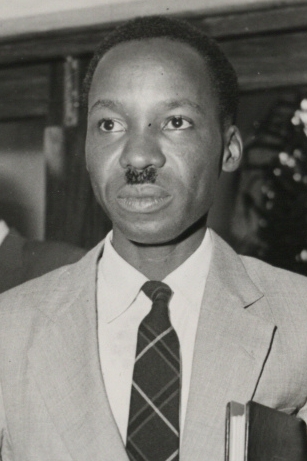
Ujamaa was a socialist ideology that formed the basis of Julius Nyerere's social and economic development policies in Tanzania after it gained independence from Britain in 1961.
Rea Vipingo is a company that operates sisal plantations in Kenya and Tanzania. The company's headquarters are located in Nairobi. Its stock was listed between 1996, and 2015 on the Nairobi Stock Exchange.

Tanga District, offcially the, Tanga City Council is one of eleven administrative districts of Tanga Region in Tanzania. The District covers an area of 596.5 km2 (230.3 sq mi). Tanga district is bordered to the north by Mkinga District, to the east by the Indian Ocean, to the south and west by Muheza District. The district is comparable in size to the land area of Guam. The administrative seat is the ward Central. The district is the administrative and economic center of Tanga Region. In Swahili, the word Tanga means "sail". According to the 2012 census, the district has a total population of 273,332.

Oscar Salathiel Kambona was the first Minister of Foreign Affairs of Tanganyika from 1963 to 1966.
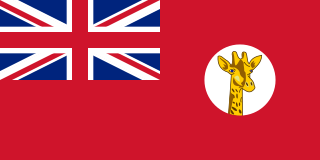
Tanganyika was a colonial territory in East Africa which was administered by the United Kingdom in various guises from 1916 until 1961. It was initially administered under a military occupation regime. From 20 July 1922, it was formalised into a League of Nations mandate under British rule. From 1946, it was administered by the UK as a United Nations trust territory.

Elizabeth II was Queen of Tanganyika from 1961 to 1962, when Tanganyika was an independent sovereign state and a constitutional monarchy. She was also the monarch of other sovereign states, including the United Kingdom. Her constitutional roles in Tanganyika were mostly delegated to the governor-general of Tanganyika.
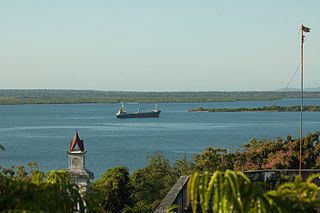
The Port of Tanga is the second largest port in Tanzania. It is located in Central ward of Tanga District of Tanga Region.

Kenya–Tanzania relations are bilateral relations between Tanzania and Kenya. Tanzania is a partner of Kenya in many areas, particularly trade, security (military), education, agriculture and energy.
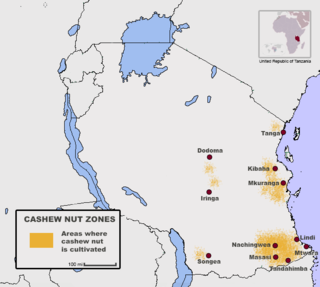
Tanzania is one of the largest cashew producers in Africa, with exports providing 10-15 percent of the country's foreign exchange. The country is the eighth-largest grower of cashew nut in the world and ranks fourth in Africa. The country provides 20% of Africa's cashew nut and only trails in production of Nigeria, Cote D'Ivoire, and Guinea-Bissau, according to figures released in 2012 by United Nations Food and Agricultural Organisation (FAO). The country has been engaged in the production of the cash crop since before independence in the years 1960s however, poor regulation and lack of reliable payments to farmers have posed significant challenges to the Cashew Nut farming industry in Tanzania. Guinea-Bissau, a country a tenth of the area of Tanzania's, has a significantly greater yield.

Agriculture is the main part of Tanzania's economy. As of 2016, Tanzania had over 44 million hectares of arable land with only 33 percent of this amount in cultivation. Almost 70 percent of the poor population live in rural areas, and almost all of them are involved in the farming sector. Land is a vital asset in ensuring food security, and among the nine main food crops in Tanzania are maize, sorghum, millet, rice, wheat, beans, cassava, potatoes, and bananas. The agricultural industry makes a large contribution to the country's foreign exchange earnings, with more than US$1 billion in earnings from cash crop exports.
Freedom of religion in Tanzania refers to the extent to which people in Tanzania are freely able to practice their religious beliefs, taking into account both government policies and societal attitudes toward religious groups.























